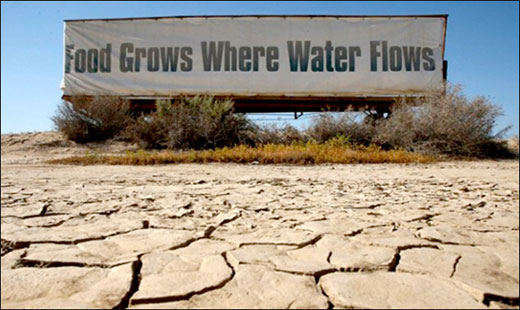
Since last year, California has been plagued by drought, with Los Angeles in particular having its driest year on record in 2013. Angelenos only saw reprieve in early March, when heavy rainfall finally arrived there. Now, scientists are warning that an even more dire situation is on the way for the Golden State: a megadrought that could last for decades, affecting everything from wildlife to agriculture.
And although the storm system that brought precipitation to LA is going to help combat the drought in the short-term, weather officials don’t believe it will have a lasting effect. The drought, of course, is a product of climate change, and it stands to reason that the two will worsen simultaneously.
Lisa Sloan, professor of Earth sciences at UC Santa Cruz, and author of a report on the issue, explained that the California drought is largely owed to the global warming-induced melting of Arctic ice. Jacob Sewall, a graduate student who co-published the report, remarked, “Where the sea ice is reduced, heat transfer from the ocean warms the atmosphere, resulting in a rising column of relatively warm air.” Sloan added, “And this will only get worse, with Arctic sea ice diminishing quickly. In fact, I think the actual situation in the next few decades could be even more dire than our study suggested.”
Climate change blogger and founding editor of Climate Progress Joseph Romm said that droughts in the western U.S. on the whole will increase in intensity and frequency as weather patterns change. He explained, “Precipitation patterns are expected to shift, expanding the dry subtropics. What precipitation there is will come in extreme deluges, resulting in runoff rather than drought alleviation. Warming causes greater evaporation and, once the ground is dry, the sun’s energy goes into baking the soil, leading to a further increase in air temperature.”
Lynn Ingram, a paleoclimatologist from the University of California Berkeley, said that megadroughts – those lasting for more than 100 years – have occurred in the past and could return. “If we go back several thousand years,” she said, “we’ve seen that droughts can last over a decade – and in some cases, over a century. We can expect that this will happen again. California should be prepared for an eventual dry period” of that magnitude.
Should this happen, it would create an increasingly desperate set of circumstances for Californians, who live in one of the largest agricultural regions in the world. The effects such a drought would have on crops would be disastrous. As a result, the cost of fruits and vegetables alone would soar, thus making it an economic issue as well.
Celeste Cantu, general manager for the Santa Ana Watershed Project Authority, said California should start preparing for this now. “There will be cataclysmic impacts. We would need to import water” to some 4.5 million southern Californians, especially ranchers and farmers.
According to paleoclimatologist Edward Cook, “the current drought” in the southwestern U.S. overall “could be classified as a megadrought – 13 years running.” He pointed out that two prior megadroughts have occurred in the Sierra Nevada of California, each last between 100 and 200 years. If the worst-case scenario comes to fruition, the state’s current dry period could last just as long. “There’s no indication it’ll be getting any better in the near term,” he concluded.
Photo: A sign above a dried-up riverbed in California’s Central Valley, which is prime agricultural land. Courtesy of EcoWatch and Center for American Progress.










